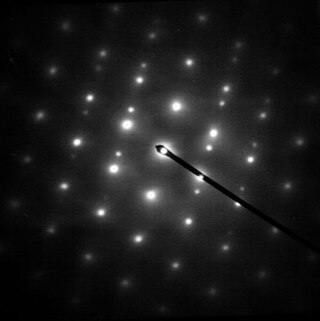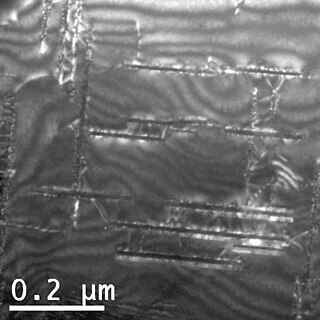
Electron diffraction is a generic term for phenomena associated with changes in the direction of electron beams due to elastic interactions with atoms. It occurs due to elastic scattering, when there is no change in the energy of the electrons. The negatively charged electrons are scattered due to Coulomb forces when they interact with both the positively charged atomic core and the negatively charged electrons around the atoms. The resulting map of the directions of the electrons far from the sample is called a diffraction pattern, see for instance Figure 1. Beyond patterns showing the directions of electrons, electron diffraction also plays a major role in the contrast of images in electron microscopes.

Alec Nigel Broers, Baron Broers is a British electrical engineer.
Sir Peter Bernhard Hirsch HonFRMS FRS is a British metallurgist who has made fundamental contributions to the application of transmission electron microscopy to metals.

David John Hugh Cockayne FRS FInstP was Professor in the physical examination of materials in the Department of Materials at the University of Oxford and professorial fellow at Linacre College from 2000 to 2009. He was the president of the International Federation of Societies for Microscopy from 2003 till 2007, then vice-president 2007 to 2010.

John Maxwell Cowley was an American Regents Professor at Arizona State University. The John M. Cowley Center for High-Resolution Electron Microscopy at Arizona State is named in his honor.
John Cowley was an extraordinarily productive scientist over more than five decades. He made pioneering contributions in the fields of electron microscopy, diffraction and crystallography, all of which brought him widespread recognition. He received the highest awards of the International Union of Crystallography, the Electron Microscopy Society of America and the American Crystallographic Society, and he was honored by election to Fellowship of the Australian Academy of Science, The Royal Society of London, and the American Physical Society. His monograph Diffraction Physics remains the standard reference in the field. His ideas, enthusiasm and basic understanding of electron optics and diffraction phenomena provided a valued source of leadership to many generations of students and co-workers, and he was universally admired by his peers and colleagues as a great and inspiring scientist.

Sir Charles William Oatley was Professor of Electrical Engineering, University of Cambridge, 1960–1971, and developer of one of the first commercial scanning electron microscopes. He was also a founder member of the Royal Academy of Engineering.

Dark-field microscopy describes microscopy methods, in both light and electron microscopy, which exclude the unscattered beam from the image. Consequently, the field around the specimen is generally dark.

Richard Henderson is a British molecular biologist and biophysicist and pioneer in the field of electron microscopy of biological molecules. Henderson shared the Nobel Prize in Chemistry in 2017 with Jacques Dubochet and Joachim Frank. "Thanks to his work, we can look at individual atoms of living nature, thanks to cryo-electron microscopes we can see details without destroying samples, and for this he won the Nobel Prize in Chemistry."

David J. Smith is a Regents' Professor of physics at Arizona State University. He is an Australian experimental physicist and his research is focussed on using the electron microscope to study the microstructure of different materials. He is a pioneer in high-resolution relectron microscopy technique and is very well known in his field. His interests are focused on thin films, nanostructures, novel materials and magnetism.

Kikuchi lines are patterns of electrons formed by scattering. They pair up to form bands in electron diffraction from single crystal specimens, there to serve as "roads in orientation-space" for microscopists uncertain of what they are looking at. In transmission electron microscopes, they are easily seen in diffraction from regions of the specimen thick enough for multiple scattering. Unlike diffraction spots, which blink on and off as one tilts the crystal, Kikuchi bands mark orientation space with well-defined intersections as well as paths connecting one intersection to the next.
Vernon Ellis Cosslett, FRS was a British microscopist.
Michael John Whelan HonFRMS FRS FInstP is a British scientist.
Knut W. Urban is a German physicist. He has been the Director of the Institute of Microstructure Research at Forschungszentrum Jülich from 1987 to 2010.

Ondrej L. Krivanek is a Czech/British physicist resident in the United States, and a leading developer of electron-optical instrumentation. He won the Kavli Prize for Nanoscience in 2020 for his substantial innovations in atomic resolution electron microscopy.

Dame Pratibha Laxman Gai-Boyes is a British microscopist and Professor and Chair of Electron Microscopy and former Director at The York JEOL Nanocentre, Departments of Chemistry and Physics, University of York. She created the atomic-resolution environmental transmission electron microscope (ETEM) and is an outspoken advocate for women with careers in science.

Zone axis, a term sometimes used to refer to "high-symmetry" orientations in a crystal, most generally refers to any direction referenced to the direct lattice of a crystal in three dimensions. It is therefore indexed with direct lattice indices, instead of with Miller indices.
John Marius Rodenburg is emeritus professor in the Department of Electronic and Electrical Engineering at the University of Sheffield. He was elected a Fellow of the Royal Society (FRS) in 2019 for "internationally recognised... work on revolutionising the imaging capability of light, X-ray and electron transmission microscopes".
Peter David Nellist, is a British physicist and materials scientist, currently a professor in the Department of Materials at the University of Oxford. He is noted for pioneering new techniques in high-resolution electron microscopy.
Angus Ian KirklandFInstP FRSC FRMS is the JEOL Professor of Electron Microscopy at the Department of Materials, University of Oxford. Professor Kirkland specialises in High-resolution transmission electron microscopy and Scanning transmission electron microscopy.

Weak beam dark field (WBDF) microscopy is a type of transmission electron microscopy (TEM) dark field imaging technique that allows for the visualization of crystal defects with high resolution and contrast. Specifically, the technique is mainly used to study crystal defects such as dislocations, stacking faults, and interfaces in crystalline materials. WBDF is a valuable tool for studying the microstructure of materials, as it can provide detailed information about the nature and distribution of defects in crystals. These characteristics can have a significant impact on material properties such as strength, ductility, and corrosion resistance.













